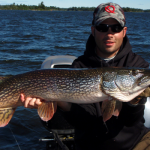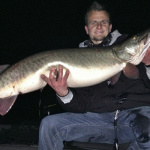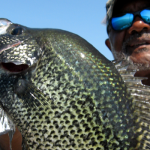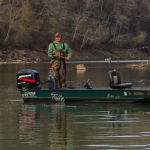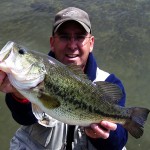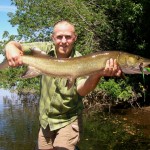By: David Graham – Date Posted: July 19, 2011
“Good for nothing, bait-stealing, stinky ‘trash fish’!” Such utterings frequently skim over heat-sheened, glassy waters straight into my ears, increasing my dismay at certain fishing superstitions. It is frustrating that the lowly gar is frequently viewed with such undeserved disdain. Unique in image and character, the longnose gar is a maligned and misunderstood freshwater oddity. Anglers who intentionally pursue the gar are few and far between, and apparently out of their minds.The longnose gar is the second largest of the gar species and certainly the most abundant. It is unequivocally a living relic with prehistoric credentials testifying to its durability. The longnose gar offers a unique set of challenges and problems that should stimulate the intellectual mind of fisherman seeking to broaden their skillset as a complete angler. It is perhaps the most common of the gar family, and is one of North America’s largest and most impressive water-bred predators. Its body is a solid tube of armored muscle that can exceed 50 inches in length, an excess of twenty pounds, and is well accustomed to taking to the air during battle. What a frighteningly delightful combination for an angler!
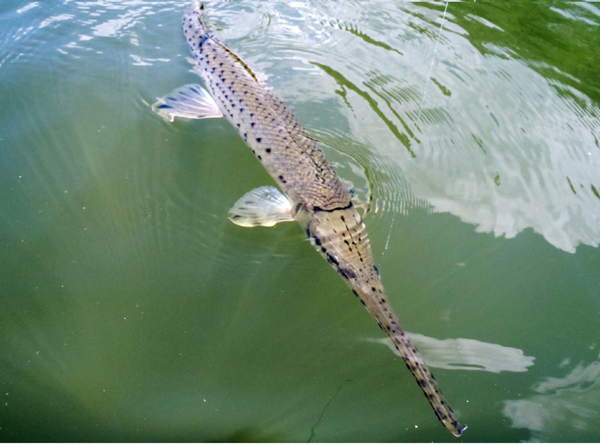
The Longnose Gar (Lepisosteus osseus) is one of North America’s most ancient inhabitants, having navigated its way through millions of years to present-day fresh waters, making it one of America’s longest-lived native species. The longnose gar can be distinguished from its counterparts the shortnose, spotted, florida, and alligator gar, by the size and shape of its bill. The longnose gar’s name is self-explanatory, proportionally; it has the longest bill length of all of the gar. Its bill is long, about twice the length of its head, and very narrow, and filled with countless razor sharp teeth. The longnose gar’s body is covered in thick bony ganoid scales. These scales interlock to produce a virtual suit of armor protecting them from its natural predators. The tail of the longnose gar is rounded; giving maximum propulsion through the water which combined with the streamlined body of the fish allows the longnose gar to display some dynamic acrobatics as they are well accustomed to taking to the air when hooked. Like the other gars, longnose gar often have an abundance of black spots on its body at some point during its lifetime, though in larger specimens these spots become less visible.
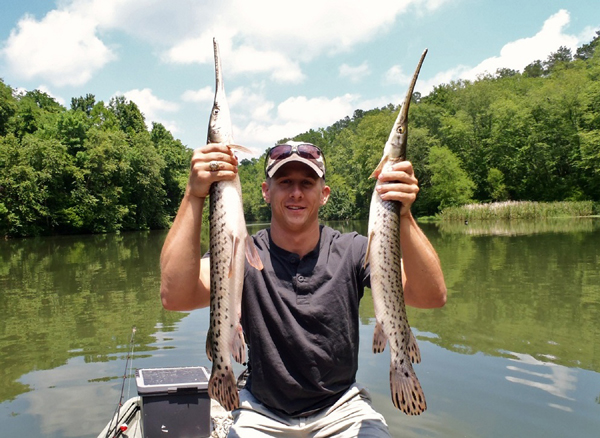
The longnose gar’s most unique feature is its head, which easily evokes images of a horror-film sea creature. Its serpent-like head sports a narrow, bony bill lined with razor-sharp teeth which increase the difficulty of hooking this fish. This gar is perfectly designed to ambush its prey. It typically floats motionless near the water’s surface, or blends seamlessly by the substrate in which it hides. A gar rarely exerts time or effort to school up and chase baitfish. It prefers to opportunistically feed on weak or dead fish, or to snatch unwary prey that wander too close to the lightning fast snap of its bill. Longnose gar feed primarily on small fish, but will eat crustaceans, insects, or other aquatic creatures within its grasp. Although frequently scorned as voracious predators that indiscriminately consume their own body weight in game fish and fish eggs in a single sitting, the longnose gar is actually somewhat sluggish and can subsist without eating for weeks at a time. It will not pass up an easy attained meal, but will rarely exert itself to energetically pursue one. Envision a submarine – steady, nearly impervious to attack, but certainly not designed to turn ‘on a dime’. Likewise, the longnose gar’s long, stiff body is ill-suited to the pursuit of quick-turning bait fish.
Longnose gar are most often found in and around shallow, weedy backwaters and sloughs, but are no strangers to rivers, often stacking up in calm eddies or at the mouths of river junctions. Longnose gar are a very common species in the Eastern U.S. They can be found as far west as Texas, spanning all across the Eastern U.S. though most abundantly in the Southern states. They have been found as far north as Southern Quebec. Anglers can typically find them in the calm pockets and eddies of tailwaters below dams and spillways. Despite their excellent camouflage, longnose gar will often forfeit safe cover to break the surface for a quick gulp of air. These fish are equipped with a swim bladder that operates as a primitive lung, allowing them to surface for reserve oxygen in conditions that cause depleted oxygen content in the waters. This occurs more often as water temperatures rise during summer months. Longnose gar will often cruise calmly in the upper levels of the water column, making them an ideal predator species for anglers who enjoy sight-casting.
The longnose gar can exceed five feet in length and weigh over twenty pounds, but it is a very slow growing fish. It does not reach sexual maturity until approximately 6 years of age and can reach a 20-year lifespan. Adult anglers who are fortunate enough to catch a particularly large longnose gar should respect the fact that it has likely overcome multiple challenges and has likely been swimming since before the angler was old enough to stand unassisted!
Conventional tackle was certainly not designed for longnose gar. These fish frequently use their long bills to catch and hold prey, swimming for some time before actually working the meal towards their throat with a series of rapid ‘chomps’. The difficulty is not in locating groups of longnose gar or in getting them to ‘bite’. Successfully hooking one, though, is certainly a challenge. These fish have no ‘broad shoulders’, but what they lack in muscular strength is made up in tenacity, athleticism, and attitude. Braided line or steel leaders are recommended. The longnose gar might not break your line in a powerful run, but they are quite capable of slicing through monofilament line. It is a spineless fish but quite capable of inflicting scratches and scrapes upon the hapless angler, and not just because of their obvious sharp teeth. These fish have gill covers and scales capable of inflicting serious cuts. They twist, turn, jump, and thrash about during their evasive maneuvering when hooked, increasing the odds that your lead line will become entrapped in teeth, gills, or the gaps between flexed scales.
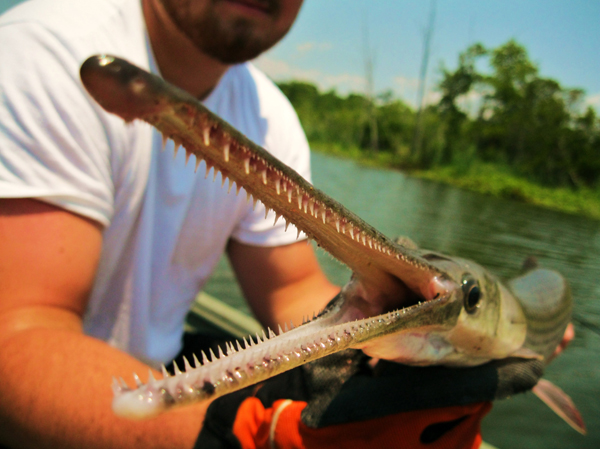
Bait fishing is a guaranteed way to get longnose gar to bite; cut or live bait of basically any sort of fish will suffice. Longnose Gar generally hover near the top of the water column, therefore using a float may be beneficial. It is important to remember several things when utilizing bait fish. Longnose gar will typically carry a bait for several minutes before actually devouring it, therefore size selection of hook and float is important. Anglers choosing to suspend a bait chunk beneath a float should carefully consider the size of the float since the resistance encountered by excessive buoyancy may cause the gar to drop the bait. The hook should be small enough to be well-concealed inside the bait, since a gar will work a bait around in its mouth for a very long time. They can detect an unnatural, hard metal shank and drop the bait. Unfortunately, allowing the fish to run with a bait for a long time will result in the occasional deep-hooked fish. It is very important to use small J-hooks, ideally with clamped barbs, which give the fish an optimal chance to recover when your only option is to cut the line and re-tie.
These are major incentives to utilize a different approach almost uniquely exclusive to landing a longnose gar. Many serious gar anglers use hookless nylon rope lures. These are designed to eliminate the driving of a shanked hook into the bony mouth of the gar, while actually using the gar’s own weapon system against it. Hookless nylon rope lures are designed to entangle the teeth of the gar’s snout in the rope fibers, ensuring that escape is nearly impossible. Rope lures are a magnificently efficient way to harmlessly catch gar. Rope lures are simple to make, and move through water with surprisingly natural fluidity. I frequently craft rope lures by simply cutting a twelve inch section of twisted nylon rope, folding it in half and feeding the looped end through a snap swivel, then bringing the two dangling ends of the rope back through the loop and synching it down. Then, simply ‘brush out’ the fibers until they resemble a doll’s straight hair. Once the lure has been dipped and water-logged it can be cast quite far.
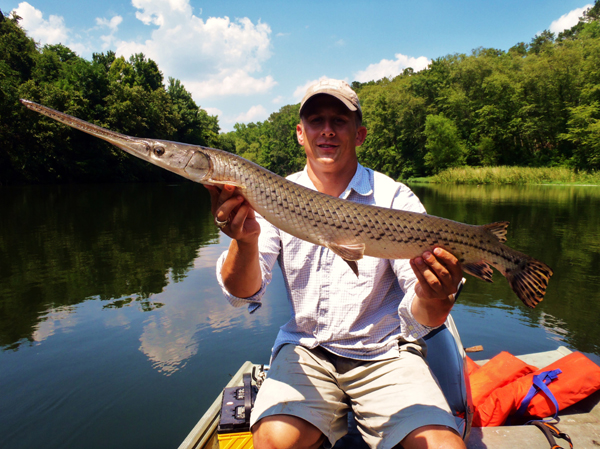
Rope lures are perfect for sight casting toward longnose gar lazily cruising the surface. A well-placed rope lure can, with a series of twitches, be brought several feet perpendicular across a gar’s face, triggering an aggressive bite response. Once the gar has firmly latched on, the angler must employ patience and self-discipline to avoid a typical instinct to set the hook. The gar will either carry the lure for a bit, or immediately shake its head to release the lure. It may be necessary to open the bail or free the spool to enable the gar to move away with the lure in its mouth, ensuring it will become securely entangled in the lure’s fibers. Removing a tangled mass of rope from a gar’s mouth can be tricky and dangerous. It is a delicate task to pry each strand from the gar’s sharp teeth, and the gar can not be expected to calmly comply. Longnose gar can safely remain above water long enough to allow the angler to carefully release rope lure threads ‘piece by piece’ instead of ripping and tearing them which could harm the fish and destroy the lure. Once a rope lure is freed from the fish’s grip, a few slaps on the water’s surface should prime it to re-cast for another fish.
There are more myths surrounding these fish than I care to count, but perhaps one of the most misleading is the notion that longnose gar are ‘trash-fish’ and unfit for consumption. The only major obstacle to cleaning and eating gar is penetrating their armor-like ganoid scales to get to the meat. Gar are often regarded as ‘bony’ and inedible, but the ‘backstrap’ of meat along its spinal cord is very thick, quality meat and mostly boneless. A great deal of meat can be found in the back strap of a 50-inch gar. Gar-cleaning, while labor-intensive, yields meat that is exceptional in taste and consistency according to those who have taken the time to do so. Recipes and instructions on cleaning and preparing gar can be easily found via internet searches.
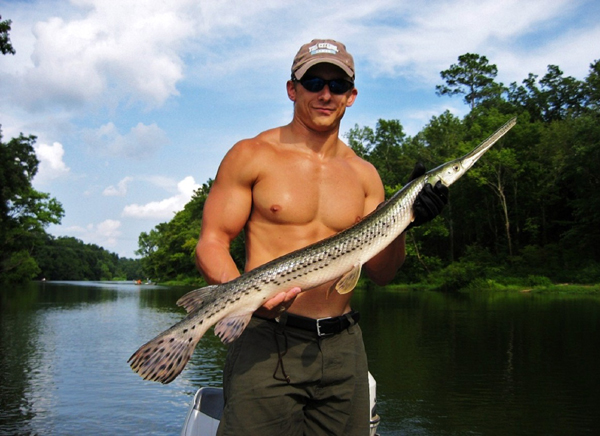
The longnose gar, and perhaps all gar in general, has been a much-maligned and misunderstood fish among generations of anglers. There does, however, appear to be a growing trend among multi-species anglers seeking to broaden fishing endeavors to pursue this apex predator. Entire groups have been established for the sole purpose of chasing gar. The Gar Anglers Sporting Society (G.A.S.S.) web page www.garfishing.com offers much insight on gar and gar fishing from scientists and fisherman alike. Anglers seeking to learn about these fish and effective methods to capture them on hook and line should explore the G.A.S.S. web page and forums, since in-depth gar fishing tips and techniques are not readily available in many traditional fishing publications.



